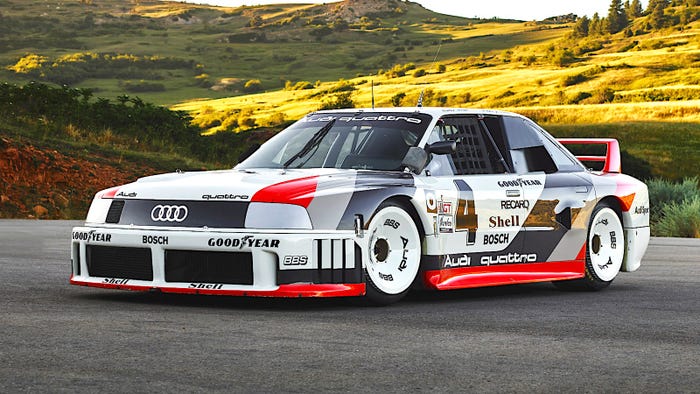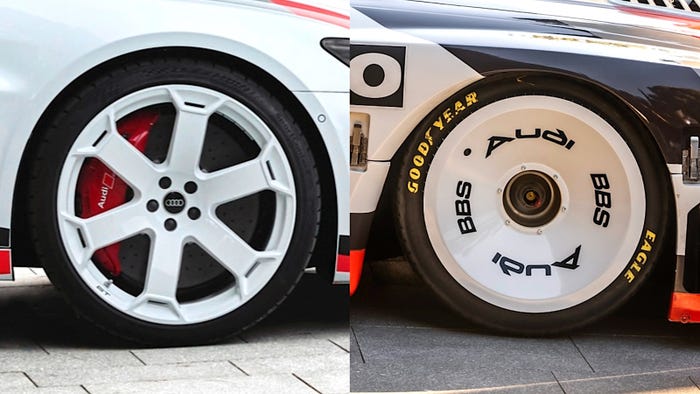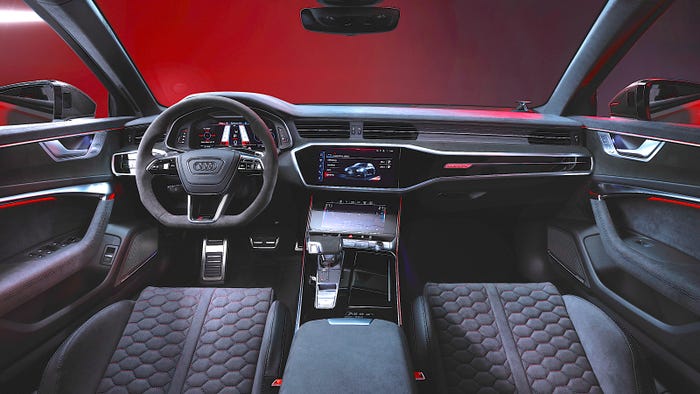Audi Channels 1989 With the 621-hp RS 6 Avant GT
Audi likes 1989 as much as Taylor Swift does.
.gif?width=700&auto=webp&quality=80&disable=upscale)
The 2025 Audi RS 6 Avant GT draws inspiration from the 1989 Quattro IMSA racer.Audi
At a Glance
- Carbon fiber hood and fenders
- Adjustable coilover suspension
- 621-horsepower twin-turbocharged V8
1989 was a good year in Audi’s history and the company is commemorating that with the speedy RS 6 Avant GT, a hot-rod station wagon that, for U.S. customers, will only be available in throwback livery commemorating the company’s race car in the U.S. IMSA series that year.
The Virginia-based Group 44 racing team of Bob Tullius ran Audi’s factory racing program in IMSA that year, racing turbocharged Quattro all-wheel-drive sedans in the team’s signature appliance white paint and the number “4” in place of the team’s eponymous “44”.
Audi designers took inspiration from the race cars’ styling when they developed the 2025 RS 6 Avant GT’s paint scheme and bodywork. That includes a lightweight carbon fiber hood, fenders that incorporate air extractors behind the wheel wells, unique rocker panels, a double-element rear wing, and new front and rear bumper fascias.

Group 44's 1989 Audi 90 Quattro IMSA race car. AUDI
Curiously, for the new car’s 6-spoke, 22-inch wheels, they borrowed from Audi’s earlier Avus concept supercar rather than replicating the IMSA race car’s iconic BBS wheels with their smooth, low-aerodynamic-drag hubs.
Alas, the modern 4.0-liter, 621-hp, turbocharged V8 engine is far too refined to produce the distinctive whistle of the IMSA race cars’ pop-off valve when it released excess pressure under deceleration, but with this kind of power, driving the RS 6 Avant GT should still be exciting. It accelerates to 60 mph in less than 3.3 seconds and achieves a 190 mph top speed.

The 2025 Audi RS 6 Avant GT wears the same gloss white pain with black and red graphics as its IMSA-racing forebear. AUDI
It sheds that speed with carbon ceramic brakes, that, combined with the grip of the new high-performance Continental “Sport Contact 7” 285/30 R22 tires, trim six feet from the car’s 60-0 mph stopping distance compared to the standard RS 6 Avant.
Some explanation of Audi’s nomenclature is in order. The “S” denotes that this is a sedan and the “6” indicates that it is a mid-size model in the middle of the company’s product line. Adding an “R” to the “S” means that this is a racy sport version of the car, making it an RS 6. You’ll notice that this is not, in fact, a sedan, but is a wagon, and Audi indicates that with the addition of the word “Avant” to the car’s name.

The six-spoke 22-inch wheels of the 2025 RS 6 Avant GT passed up the chance to reflect the slick style of the BBS wheels on the 1989 race car. AUDI
This latest limited-production version – they’ll build only 660 of them – adds “GT” to the end of the time to indicate that this is the pinnacle maximum-performance edition. Presto: Audi RS 6 Avant GT.

The cabin of the 2025 Audi RS 6 Avant GT boasts seats with a honeycomb pattern that shimmers in Express Red, while that on the outer seam of the bucket seat is finished in copper. AUDI
This is an Audi, so naturally, just as in the old race car, power is routed to all four wheels through the company’s Quattro all-wheel drive system. While the ’89 IMSA racer employed an H-pattern manual-shift gearbox, the RS 6 Avant GT has an 8-speed Tiptronic dual-clutch automated manual with computer-optimized shifting.
A lightweight, compact, locking center differential normally splits engine power 40/60 to the car’s front and rear axles, providing the sensation of rear drive with the grip and acceleration of all-wheel-drive. If there is slippage, the diff can send as much as 70 percent to the front or 85 percent to the rear axle.
All-wheel-drive cars can suffer from front-drive-like understeer due to the power transfer through the front tires’ contact patches diminishing available grip for cornering, but Audi promises that effect is minimized by this new center differential. The rear differential also gets special tuning with a focus on greater agility and rear bias when driving in “dynamic” mode for sporty, neutral, and highly precise handling.
That handling is enhanced by the substitution of triple-adjustable coilover-shock suspension that Audi designed and builds in-house. This provides a 10mm lower ride height than the regular RS 6 Avant. The GT’s suspension also includes a 30 percent stiffer front anti-roll bar and an 80 percent stiffer rear bar for better control of body roll in turns.
The shocks are the traditional manual adjustment kind, so Audi provides a tool kit and instructions for owners to dial in the settings for high-speed compression (as when the car strikes a bump), low-speed compression (as when the car turns or decelerates), and rebound, when the spring reacts to compression following any of those events.
The less dedicated can opt for the same electronically controlled Dynamic Ride Control system or the adaptive air suspension from the standard RS 6, but that seems to spoil the unique character of the limited-edition model.
As a special car, the RS 6 Avant GT isn’t built on the regular assembly line. The car does start at Audi’s Neckarsulm production line and paint shop, but then it gets shipped to Böllinger Höfe, where the Audi R8, Audi e-tron GT Quattro, and RS e-tron GT are built in limited production.

A completed 2025 Audi RS 6 Avant GT in the final inspection area of the Böllinger Höfe plant. AUDI
Final assembly is performed there by a dedicated team of just seven experienced employees working at three assembly stations that were set up especially for this exclusive special edition. The job takes a day for each car, as all of the GT-specific features are installed by hand.
Audi says that the Böllinger Höfe facility uses green electricity and heat from renewable sources. But for U.S. buyers, the factory is the only green part of the RS 6 Avant GT, because Audi will only sell cars that are headed to America in the glossy white color scheme of the 1989 Group 44 IMSA racing Quattro. Group 44 boss Bob Tullius should be proud.
About the Author(s)
You May Also Like





